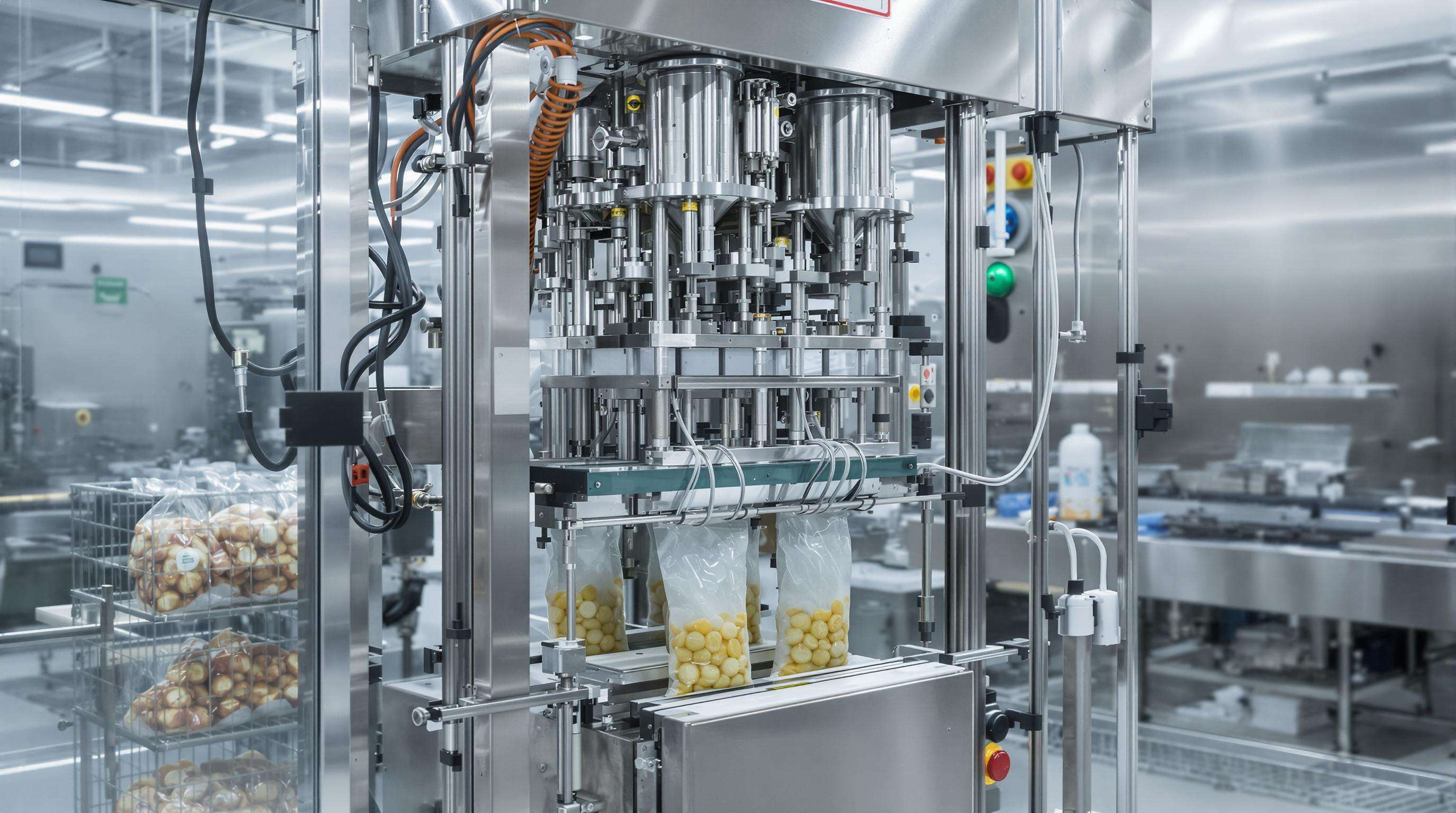Article
Vertical Form-Fill-Seal (VFFS) Food Bagging Machines

How Vertical Food Packaging Machines Operate
VFFS machines automate the process of converting roll stock into final product. Film is advanced vertically around the forming collar to form a tube of film. The product is fed in through a fill tube with the bottom seal being made by the heat-sealing jaws. The top is sealed and detached after filling with an exact volume. This uninterrupted, high-speed operation occupies very little floor space and is designed to meet food-grade sanitation standards. Operators are mainly responsible for loading film, making adjustments, and correcting faults.
Key Applications: Granules, Powders & Snack Foods
VFFS is excellent for any free flowing dry product, and maintains accuracy and hermetic seals. Granular commodities such as sugar, rice and coffee are responsible for more than half of shipments. Powders (including flour, milk powder and spices) benefit from dust-tight filling heads, and irregular solids (like snack mixes and frozen vegetables) can be accommodated by vibratory feed systems. Based on Reading Between the Lines of a Packaging Market Analysis 2025, customized configurations now manage to process liquids such as dressings and sauces with specific nozzles that include spill containment.
Space Efficiency Advantages in Small Facilities
VFFS technology saves production floor space by combining forming, filling and sealing operations in a single vertical axis. They can be accommodated in spaces as small as 200 sq. ft., great for bakeries, spice grinders, or co-packing. The vertical configuration allows for easy placement under overhead supply lines, thereby eliminating the necessity for pre-made bags.
Horizontal Form-Fill-Seal (HFFS) Food Packaging Systems
Mechanisms Behind Horizontal Food Bagging Automation
HFFS machines work on a horizontal axis and take the pouches formed from film rolls before the products are filled. Unlike vertical systems, the articles are transported in the direction of the production line, this reduces the drops, providing protection for delicate products. Film is unrewound through the manufacture of collars and the feed is controlled by synchronised conveyors. Cringe seal jaws form bottom and sidewalls, and have side filling openings to automatically reduce spills.
Ideal for Liquid Products & Delicate Bakery Items
HFFS equipment excels with liquids and delicate items like croissants or frosted pastries, as transverse filling tubes reduce splashing compared to gravity-dependent systems. The inline lateral motion prevents product shifts, preserving presentation quality.
High-Speed Production Line Integration
HFFS machines sync seamlessly with upstream processes (portioning stations) and downstream units (labeling systems). Their flat-profile footprint minimizes gaps, achieving over 120 pouches/minute. Standard PLC interfaces simplify facility network integration, reducing retrofit costs for high-volume operations.
Comparative Analysis: Vertical vs Horizontal Food Bagging Machines

Speed vs Flexibility: Production Volume Considerations
Vertical machines offer flexibility, handling diverse products at 150–300 bags/minute. Horizontal systems prioritize speed, exceeding 400 bags/minute for uniform items like protein bars. Vertical solutions suit smaller batches with frequent changes, while horizontal automation fits high-volume standardized production.
Floor Space Requirements Compared
VFFS systems require 30–50% less space than horizontal models, ideal for facilities under 10,000 sq. ft. Horizontal machines need wider lines but integrate seamlessly with conveyor workflows.
Cost Differences in Initial Investment
Horizontal machines cost 40–60% more upfront, with premium models exceeding $250k. Vertical options start under $80k, targeting SMEs. Horizontal systems offer faster ROI for high-volume operations, while vertical machines reduce capital risk for gradual scaling.
Specialized Food Bagging Machine Types
Flow Wrap Machines for Individual Portions
Flow wrappers encase products in airtight pouches using continuous film, ideal for protein bars and biscuits. They reduce film usage by up to 23% compared to pre-formed pouches, while printed films enable branding and moisture barriers.
Stick Pack Systems for Single-Serve Products
Stick pack machines create slender, cylindrical pouches for granules and liquid concentrates (0.5g–25mL). They reduce shipping volume by nearly 40% and preserve flavor with resealable tear-off tops, ideal for coffee powders and condiment samples.
Selecting Food Packaging Automation Systems
Product Compatibility Testing Essentials
Assess material flow, particle size, and moisture against machine specs. Trial runs verify sealing consistency and transfer efficiency, avoiding costly post-installation adjustments.
Budget Planning for Machine Acquisition
Balance capital expenditures and operational costs. Initial investments often exceed $200k for mid-range systems, requiring careful ROI analysis, as highlighted in the North America Food Packaging Automation Report. Prioritize essential functionalities with phased upgrade options.
Future-Proofing with Scalable Systems
Choose modular systems with upgradeable components (PLCs, sealing jaws). Cloud-connected models enable remote monitoring and predictive maintenance, aligning with evolving packaging trends.
Emerging Technologies in Food Bagging Machines
AI-Driven Quality Control Implementations
AI-powered inspection systems detect flaws in real-time, analyzing seals and fill accuracy. They reduce rejection rates by 23% while optimizing material use and predicting maintenance needs.
Sustainability-Focused Packaging Innovations
Energy-saving drives and waste-reduction mechanisms integrate biodegradable films without sacrificing durability. Next-gen machines cut energy use by 38%, crucial for meeting tightening regulations.
FAQ
What types of products can VFFS machines handle?
VFFS machines are suitable for free-flowing dry products, granular commodities like sugar and coffee, powders such as flour and spices, and irregular solids like snack mixes and frozen vegetables.
What are the advantages of HFFS machines?
HFFS machines are ideal for liquid products and delicate bakery items. They offer high-speed production line integration and provide superior protection for delicate products due to their horizontal axis operation.
How do vertical and horizontal food bagging machines compare?
Vertical machines offer flexibility and require less space, handling 150-300 bags per minute. Horizontal systems focus on speed with over 400 bags per minute, suited for high-volume standardized production and offering a higher ROI for such operations.
What are specialized food bagging machines?
Flow wrap machines are ideal for individual portions like protein bars, while stick pack systems are designed for single-serve products like coffee powders. They offer film and space-saving benefits.
Table of Contents
- Article
- Vertical Form-Fill-Seal (VFFS) Food Bagging Machines
- Horizontal Form-Fill-Seal (HFFS) Food Packaging Systems
- Comparative Analysis: Vertical vs Horizontal Food Bagging Machines
- Specialized Food Bagging Machine Types
- Selecting Food Packaging Automation Systems
- Emerging Technologies in Food Bagging Machines
- FAQ

